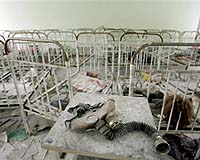| . |  |
. |
Beirut, Lebanon (UPI) Apr 20, 2010 Amid the growing concerns of Western intelligence services that al-Qaida appears to be building up its capabilities in Yemen and Somalia, the focus is increasingly on one man in the jihadist leadership: Mohammed Ilyas Kashmiri. He commands al-Qaida's elite and infamous Brigade 313, named after the number of supporters who stood with the Prophet Mohammed in a seventh-century battle and defeated a far larger force. Kashmiri's hand has been seen in a recent spate of attacks and planned operations in India, including the November 2008 carnage in Mumbai; Pakistan; Afghanistan, including the suicide bombing of a CIA base; and as far afield as the Caucasus and Denmark. The 6-foot-tall Kashmiri, a 45-year-old Pakistani, has been active since the 1979-89 war against the Soviet army in Afghanistan and lost an eye in combat. In 1991, he became an Islamist leader fighting India in the disputed region of Kashmir, his native province. He joined Osama bin Laden in 2005 and is considered one of the top military commanders in al-Qaida. The shadowy Brigade 313 is one of six known operational units of al-Qaida's paramilitary wing, Lashkar al-Zil, or the Shadow Army. Its members are all battle-hardened veteran operatives. It was formed after the U.S. invasion of Iraq in March 2003 and so secretive it hardly ever claims responsibility for its operations. Kashmiri is virtually unknown outside the intelligence and counter-terrorism communities but he is rated as a most dangerous adversary, deadly, innovative, bold and hard to track. So far his main operations have been directed against U.S. and Pakistani forces, including at least two attempts to assassinate Pervez Musharraf when Musharraf was president of Pakistan. But Kashmiri has his one good eye on unleashing attacks in the United States. On Oct. 27, 2009, the U.S. Department of Justice named him a conspirator with Pakistani-born American citizen David Headley arrested by the FBI Oct. 3 for plotting terrorist attacks in India and Denmark. Prominent Indian analyst B. Rahman says Kashmiri "sees himself as another Khaled Sheik Mohammed and wants to carry out a spectacular terrorist strike in a Western country." Kashmiri's status -- some reports say he oversees al-Qaida's global operations -- is such that he has been targeted for assassination in at least three CIA drone attacks since May 2009. Pakistani intelligence and the CIA pronounced him dead after a Sept. 7 missile attack in North Waziristan, part of the tribal belt in northwestern Pakistan. But he turned up alive and well. Pakistani journalist Syed Saleem Shahzad, who has extensive contacts with Islamist radicals in Pakistan and Afghanistan, interviewed Kashmiri in Waziristan in October and quoted him as saying the jihadist war would be expanded to the United States and Israel. "Our battle cannot be against Muslims and believers," he said. "The real game is the fight against the Great Satan and its adherents." Shahzad, writing in Asia Times Online, noted: "If today al-Qaida is divided into three spheres, Osama bin laden is undoubtedly the symbol of the movement and his deputy, Ayman al-Zawahiri, defines al-Qaida's ideology and broader strategic vision. "Kashmiri, with his unmatched guerrilla expertise, turns the strategic vision into reality, provides the resources and achieves objectives but he chooses to remain in the background and to be very low key." Shahzad noted that Brigade 313 "is believed to be the main catalyst of high-profile operations such as the one in Mumbai and others in Afghanistan, as well as al-Qaida's operations in Somalia and to some extent in Iraq." Western intelligence officials say there is a growing shift of veteran al-Qaida fighters and field commanders from the Afghanistan-Pakistan theater to Yemen and Somalia to bolster jihadist forces there and probably open a new front against the United States. Exactly what Kashmiri's role in all this isn't clear. But the involvement of al-Qaida's organization in Yemen in recent U.S. operations -- the November killings at Fort Hood, Texas, and the Christmas Day attempt to blow up an airliner over Detroit -- fit his objective of mounting high-profile attacks inside the United States.
Share This Article With Planet Earth
Related Links The Long War - Doctrine and Application
 Sniffer detects airborne chemical risks
Sniffer detects airborne chemical risksIrvine, Calif. (UPI) Apr 20, 2010 A new sniffer sensor that can spot suspect chemical content or residue is winning support from the military, which plans to use it on unmanned aircraft, a U.S. company said. Ionfinity, a security technology subsidiary of the alternate energy company Viaspace, said it will receive an additional funding of $786,000 from the U.S. Navy for a contract awarded earlier to develop the sensor. / ... read more |
|
| The content herein, unless otherwise known to be public domain, are Copyright 1995-2010 - SpaceDaily. AFP and UPI Wire Stories are copyright Agence France-Presse and United Press International. ESA Portal Reports are copyright European Space Agency. All NASA sourced material is public domain. Additional copyrights may apply in whole or part to other bona fide parties. Advertising does not imply endorsement,agreement or approval of any opinions, statements or information provided by SpaceDaily on any Web page published or hosted by SpaceDaily. Privacy Statement |